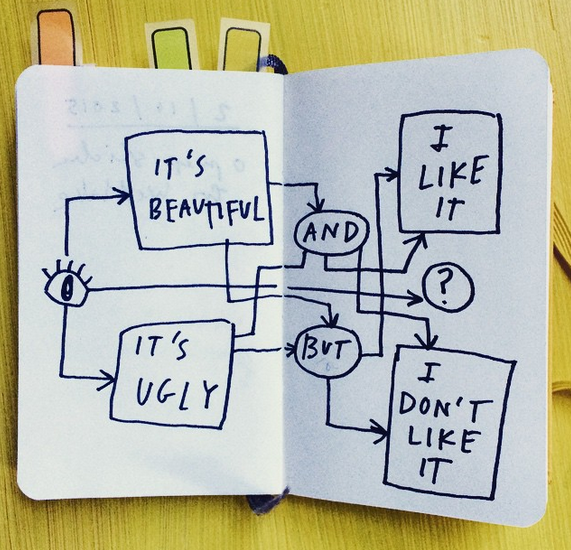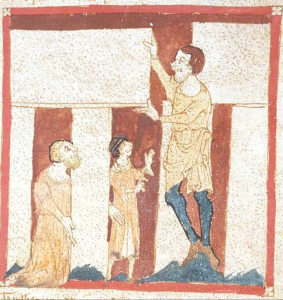
Art is subjective, we choose what we like. I like this painting. I like the tall, dramatic corn growing up into the bright sky. But I made it, so I know what I like about it.

What makes us distinguish between likable or not likable, beautiful or ugly, good or bad?
In 2012, the Huffington Post reported on an episode of the PBS program Antiques Roadshow. A man brought in two paintings which he purchased for $2.50 each. He liked one painting but thought the other one was ugly. Turns out that the ‘ugly’ one, by American artist Willaim Victor Higgins (apologies to Mr. Higgins) was appraised for $75,000 to $100,000. The one he liked didn’t have much monetary worth at all. Beautiful and ugly can be at odds when it comes to personal taste, not to mention cash value! (Why he bothered to buy what he considered to be an ugly painting wasn’t explained, but in the end you can bet he was glad he did.)
Our sociological patterns of choice and preference refer to how we view and adapt to styles, manners, and all kinds of things – including works of art. Our individual tastes are influenced by many factors, but we know what we like.

We all love the wonderful, brilliant paintings created by our 5-year-olds. I love everything the Beatles have done – been a fan for 50 years. I took a quick survey from some of my near and dear. Husband Chris loves the paintings of Johannes Vermeer. Nephew Steve loves Tool and van Gogh. Daughter Cara goes crazy for Bernini, Caravaggio and post-impressionist landscapes. Son-in-law James is enthralled with jazz artist Sonny Rollins and metal bands. Bunny is enchanted by Puccini. Rosemary chooses Verdi, Springsteen, Gothic architecture, Shakespeare and wants to know if France and flowering trees can be considered art forms. Peter weighs in with more metal bands and JMW Turner. Doug’s picks are John Singer Sargent and the pre-Raphaelites. There were more lists, and longer, but you get the idea. This was eye-opening for me!
Make a list of your favorite artists then take a survey of your own. You’ll learn a lot about your people!
We also know what we don’t like, but it’s important to remember that we are judging through a lens of personal preference – our personal taste. Even when we aren’t warming up to a painting, a song, a poem, or whatever it is, we can often appreciate art for it’s own inherent, redeeming qualities.

Long ago I laid eyes on the watercolor paintings of Paul Cezanne and have been in awe ever since. His watercolors have proved a huge influence for me (thank you, Monsieur Cezanne). And even though I’m not enamored of his oil paintings, I realize that Cezanne was the father of modern art, a breakthrough genius, and I certainly appreciate his vision.
I’m not fond of Led Zeppelin’s music (my regrets LZ fans) but their talent is obvious. ‘Stairway to Heaven’ – yes, I get it.
And so, rather than discounting any work of art entirely, it’s possible to stretch the imagination and come to realize it’s intrinsic value. Of Led Zeppelin’s music I might say:
That song makes my heart feel like it’s beating the wrong way, but it’s because of the band’s phenomenal rhythmic patterns.
Of another artist that proves difficult for me:
It hurts to look at some of Francisco Goya’s paintings, like Satan Devouring His Son and A Pilgrimage To San Isidro. They’re really disturbing, but Goya’s talent is amazing.
I love Stonehenge. Those who don’t might consider that even though…
Stonehenge is just a bunch of stones, and some are broken or missing, no one knows how this 5000 year old earth work was erected, or how 50 ton rocks were transported over 200 miles to build it, or for what purpose. Modern-day experts have theorized about it for hundreds of years. It’s an astounding neolithic mystery and a tribute to the people who created it.
The important thing is, we can appreciate even what we don’t like.

